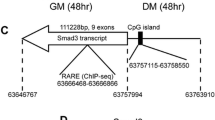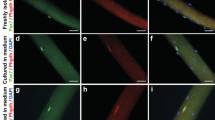Abstract
To understand the mechanism of muscle remodeling during Xenopus laevis metamorphosis, we examined the in vitro effect of insulin-like growth factor 1 (IGF-1) on growth and differentiation of three different-fate myogenic cell populations: tadpole tail, tadpole dorsal, and young adult leg muscle. IGF-1 promoted growth and differentiation of both tail and leg myogenic cells only under conditions where these cells could proliferate. Inhibition of cell proliferation by DNA synthesis inhibitor cytosine arabinoside completely canceled the IGF-1’s cell differentiation promotion, suggesting the possibility that IGF-1’s differentiation-promotion effect is an indirect effect via IGF-1’s cell proliferation promotion. IGF-1 promoted differentiation dose dependently with maximum effect at 100–500 ng/ml. RT-PCR analysis revealed the upregulation (11-fold) of ifg1 mRNA expression in developing limbs, suggesting that IGF-1 plays a role in promoting muscle differentiation during limb development. The combined effect of triiodo-l-thyronine (T3) and IGF-1 was also examined. In adult leg cells, IGF-1 promoted growth and differentiation irrespective of the presence of T3. In larval tail cells, cell count was 76% lower in the presence of T3, and IGF-1 did not promote proliferation and differentiation in T3-containing medium. In larval dorsal cells, cell count was also lower in the presence of T3, but IGF-1 enhanced proliferation and differentiation in T3-containing medium. This result is likely due to the presence among dorsal cells of both adult and larval types (1:1). Thus, IGF-1 affects only adult-type myogenic cells in the presence of T3 and helps accelerate dorsal muscle remodeling during metamorphosis.










Similar content being viewed by others
References
Adams GR, Haddad F (1996) The relationships among IGF-1, DNA content, and protein accumulation during skeletal muscle hypertrophy. J Appl Physiol 81:2509–2516
Adams GR, McCue SA (1998) Localized infusion of IGF-I results in skeletal muscle hypertrophy in rats. J Appl Physiol 84:1716–1722
Adi S, Bin-Abbas B, NY W, Rosenthal SM (2002) Early stimulation and late inhibition of extracellular signal-regulated kinase 1/2 phosphorylation by IGF-I: a potential mechanism mediating the switch in IGF-I action on skeletal muscle cell differentiation. Endocrinology 143:511–516
Allen RE, Boxhorn LK (1989) Regulation of skeletal muscle satellite cell proliferation and differentiation by transforming growth factor-beta, insulin-like growth factor I, and fibroblast growth factor. J Cell Physiol 138:311–315
Brunk CF, Jones KC, James TW (1979) Assay for nanogram quantities of DNA in cellular homogenates. Anal Biochem 92:497–500
Daughaday WH, Hall K, Raben MS, Salmon WD, Van Den Brande JL, Van Wyk JJ (1972) Somatomedin: proposed designation for sulphation factor. Nature 235:107
Díaz M, Vraskou Y, Gutiérrez J, Planas JV (2009) Expression of rainbow trout glucose transporters GLUT1 and GLUT4 during in vitro muscle cell differentiation and regulation by insulin and IGF-I. Am J Physiol Regul Integr Comp Physiol 296:R794–R800
Duclos MJ, Wilkie RS, Goddard C (1991) Stimulation of DNA synthesis in chicken muscle satellite cells by insulin and insulin-like growth factors: evidence for exclusive mediation by a type-I insulin-like growth factor receptor. J Endocrinol 128:35–42
Engert JC, Berglund EB, Rosenthal N (1996) Proliferation precedes differentiation in IGF-I-stimulated myogenesis. J Cell Biol 135:431–440
Gabillard JC, Sabin N, Paboeuf G (2010) In vitro characterization of proliferation and differentiation of trout satellite cells. Cell Tissue Res 342:471–477
Guo K, Wang J, Andre V, Smith R, Walsh K (1995) Myod-induced expression of p21 inhibits cyclin-dependent kinase activity upon myocyte terminal differentiation. Mol Cell Biol 15:3823–3829
Honegger A, Humbel RE (1986) Insulin-like growth factors I and II in fetal and adult bovine serum. J Biol Chem 261:569–575
Huang H, Cai L, Remo BF, Brown DD (2001) Timing of metamorphosis and the onset of the negative feedback loop between the thyroid gland and the pituitary is controlled by type II iodothyronine deiodinase in Xenopus laevis. Proc Natl Acad Sc USA 98:7348–7353
Jacquemin V, Furling D, Bigot A, Butler-Browne GS, Mouly V (2004) IGF-1 induces human myotube hypertrophy by increasing cell recruitment. Exp Cell Res 299:148–158
Lo DC, Allen F, Brockes JP (1993) Reversal of muscle differentiation during urodele limb regeneration. Proc Natl Acad Sci U S A 90:7230–7234
Machida S, Spangenburg EE, Booth FW (2003) Forkhead transcription factor FoxO1 transduces insulin-like growth factor’s signal to p27Kip1 in primary skeletal muscle satellite cells. J Cell Physiol 196:523–531
Mathews LS, Norstedt G, Palmiter RD (1986) Regulation of insulin-like growth factor I gene expression by growth hormone. Proc Natl Acad Sci U S A 83:9343–9347
McFarland DC, Pesall JE, Gilkerson KK (1993) The influence of growth factors on Turkey embryonic myoblasts and satellite cells in vitro. Gen Comp Endocrinol 89:415–424
Nieuwkoop PD, Faber J (1967) Normal table of Xenopus laevis (Daudin). North-Holland Publishing Co, Amsterdam
Nishikawa A, Hayashi H (1994) Isoform transition of contractile proteins related to muscle remodeling with an axial gradient during metamorphosis in Xenopus laevis. Dev Biol 165:86–94
Nishikawa A, Hayashi H (1995) Spatial, temporal and hormonal regulation of programmed muscle cell death during metamorphosis of the frog Xenopus laevis. Differentiation 59:207–214
Perrini S, Laviola L, Carreira MC, Cignarelli A, Natalicchio A, Giorgino F (2010) The GH/IGF1 axis and signaling pathways in the muscle and bone: mechanisms underlying age-related skeletal muscle wasting and osteoporosis. J Endocrinol 205:201–210
Rando TA, Blau HM (1994) Primary mouse myoblast purification, characterization, and transplantation for cell-mediated gene therapy. J Cell Biol 125:1275–1287
Richard-Parpaillon L, Héligon C, Chesnel F, Boujard D, Philpott A (2002) The IGF pathway regulates head formation by inhibiting Wnt signaling in Xenopus. Dev Biol 244:407–417
Rinderknecht E, Humbel RE (1978) The amino acid sequence of human insulin-like growth factor I and its structural homology with proinsulin. J Biol Chem 253:2769–2776
Rodgers JT, King KY, Brett JO, Cromie MJ, Charville GW, Maguire KK, Brunson C, Mastey N, Liu L, Tsai CR, Goodell MA, Rando TA (2014) mTORC1 controls the adaptive transition of quiescent stem cells from G0 to G Alert. Nature 510:393–396
Rommel C, Bodine S, Clarke B, Rossman R, Nunez L, Stitt TN, Yancopoulos GD, Glass DJ (2001) Mediation of IGF-1-induced skeletal myotube hypertrophy by PI(3)K/Akt/mTOR and PI(3)K/Akt/GSK3 pathways. Nat Cell Biol 3:1009–1013
Rosenthal SM, Cheng ZQ (1995) Opposing early and late effects of insulin-like growth factor I on differentiation and the cell cycle regulatory retinoblastoma protein in skeletal myoblasts. Proc Natl Acad Sci U S A 92:10307–10311
Samuels HH, Stanley F, Casanova J (1979) Depletion of L-3, 5, 3′-triiodothyronine and L-thyroxine in euthyroid calf serum for use in cell culture studies of the action of thyroid hormone. Endocrinology 105:80–85
Schmid C, Steiner T, Froesch ER (1983) Preferential enhancement of myoblast differentiation by insulin-like growth factors (IGF I and IGF II) in primary cultures of chicken embryonic cells. FEBS Lett 161:117–121
Semsarian C, Sutrave P, Richmond DR, Graham RM (1999) Insulin-like growth factor (IGF-I) induces myotube hypertrophy associated with an increase in anaerobic glycolysis in a clonal skeletal-muscle cell model. Biochem J 339:443–451
Shibota Y, Kaneko Y, Kuroda M, Nishikawa A (2000) Larval-to-adult conversion of a myogenic system in the frog, Xenopus laevis, by larval-type myoblast-specific control of cell division, cell differentiation, and programmed cell death by triiodo-L-thyronine. Differentiation 66:227–238
Shimizu-Nishikawa K, Shibota Y, Takei A, Kuroda M, Nishikawa A (2002) Regulation of specific developmental fates of larval- and adult-type muscles during metamorphosis of the frog Xenopus. Dev Biol 251:91–104
Yamane H, Nishikawa A (2013) Differential muscle regulatory factor gene expression between larval and adult myogenesis in the frog Xenopus laevis: adult myogenic cell-specific myf5 upregulation and its relation to the notochord suppression of adult muscle differentiation. In Vitro Cell Dev Biol Anim 49:524–536
Yamane H, Ihara S, Kuroda M, Nishikawa A (2011) Adult-type myogenesis of the frog Xenopus laevis specifically suppressed by notochord cells but promoted by spinal cord cells in vitro. In Vitro Cell Dev Biol Anim 47:470–483
Author information
Authors and Affiliations
Corresponding author
Additional information
Editor: Tetsuji Okamoto
Rights and permissions
About this article
Cite this article
Miyata, S., Yada, T., Ishikawa, N. et al. Insulin-like growth factor 1 regulation of proliferation and differentiation of Xenopus laevis myogenic cells in vitro. In Vitro Cell.Dev.Biol.-Animal 53, 231–247 (2017). https://doi.org/10.1007/s11626-016-0099-9
Received:
Accepted:
Published:
Issue Date:
DOI: https://doi.org/10.1007/s11626-016-0099-9




